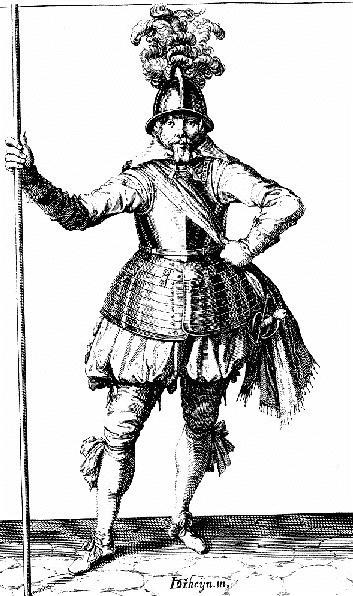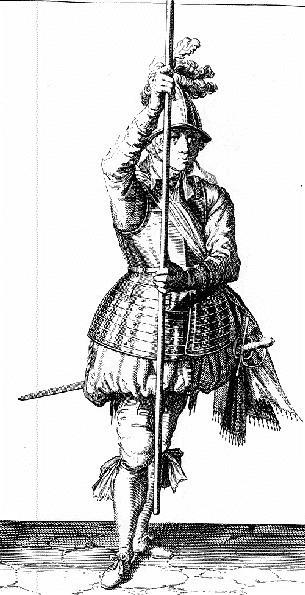
Advance your Pike (first motion)
In the 2.. figure is shewed, how, before the first changeinge of his
holde, he shall with the right hand lift the Pike a little from the round
and take it sodainely again with the left hand towardes the neather ende,
leavinge so much lengthe belowe as he can afterwardes reach well with the
right hand, like as this figure doth teache.
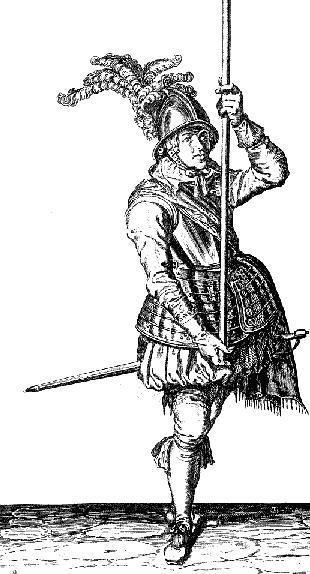
Advance your Pike (second motion)
In the 3. how he, before the second changeinge of hold, shall lift
up the Pike with the left hand and quickely with the right hand,
take the same at the ende.

Advance your pike (third motion)
In the 4. how, before the third changeinge of hold. (having ioyned
the Pike with the left hand against the right arme) he shall governe the
same against the sayde arme and carry it up, or advanced.
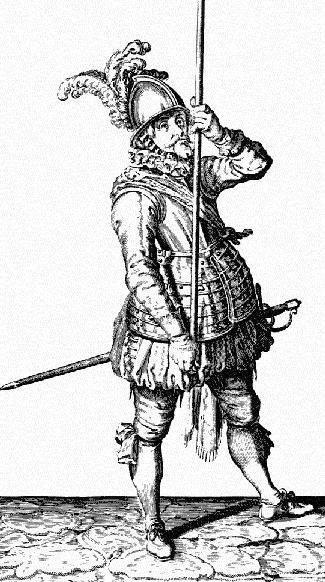
Order your Pike (first motion)
In the 5. how (havinge carried the Pike advanced) he shall set the
same downe upon the ground againe in threed tymes, like as before, that
is: he shall let the right hand with the Pike sinke a little together,
and for teh first changeinge of handes, with the left hand take the same
upwards, like as this figure teachet.
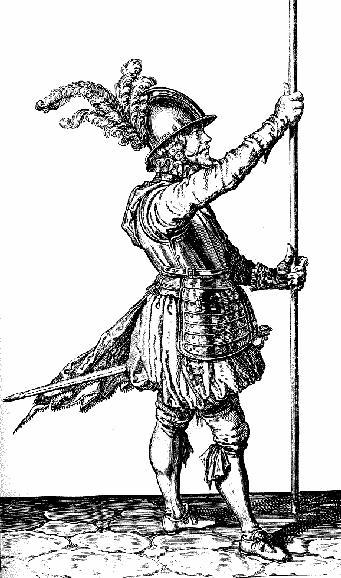
Order your Pike (second motion)
In the 6. how, to change the second hold, he shall let the Pike sinke
with the left hand and with the right hand quickely take the same heigher,
like as this figure sheweth.
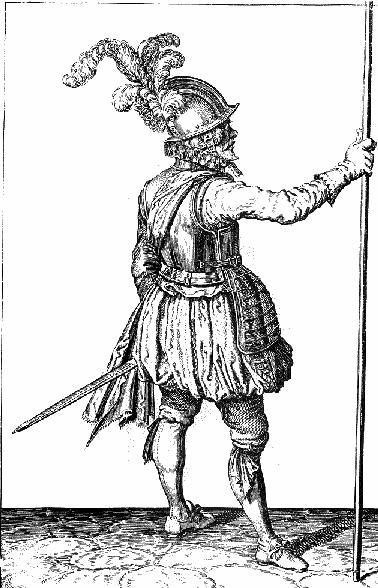
Order your Pike (third motion)
In the 7. how at the third changeinge of holde, he shall governe the
Pike with the right hand onely and set it againe upon the ground, as is
taught in the first figure, and if he will then laye the Pike upon the
shoulder, he shall doe that againe in three tymes as followeth.
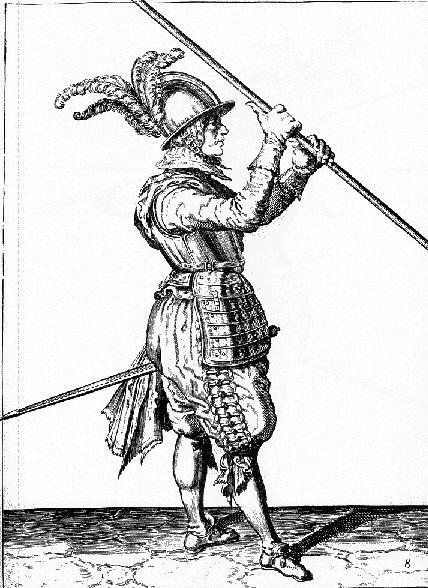
Shoulder and carry it levell (first motion)
In the 8. place is shewed, how, before the first changeinge of holde
(having the Pike in the right hand) he shall let the same fall over a little
against the thumbe and presently take it with the left hand close to the
right hand , like as this figure sheweth.
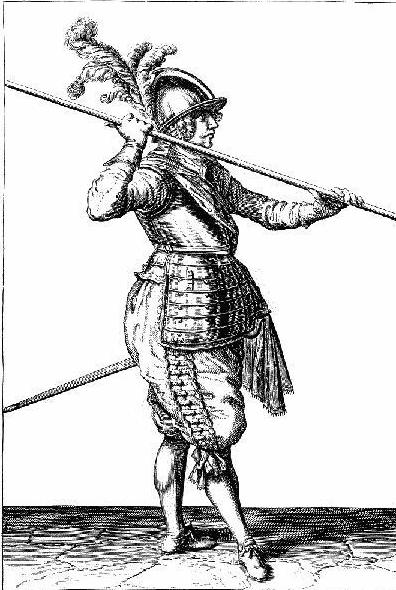
Shoulder your Pike and carry it levell (second motion)
In the 9. how he (before the second changeinge of hold) shall bringe
the Pike foreward with the left hand an with the right hand take hold backward,
the more handsomely and gracefully to lay the Pike on the shoulder.
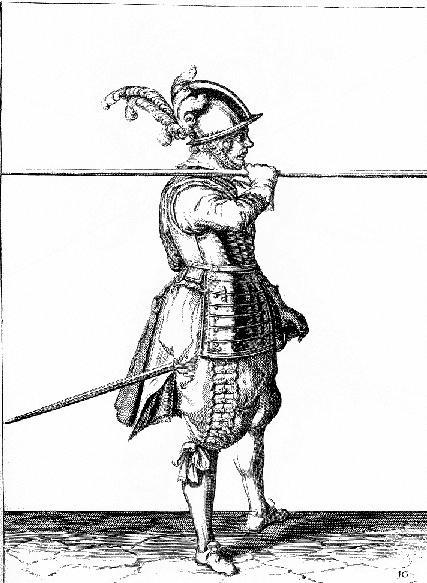
Shoulder your Pike and carry it levell (third motion).
In the 10. how he (in the third changeinge of hold) shall carye the
Pike levell upon the shoulder, hold the right arme up and the thumbe against
the pike, not onely for fashions sake, but because he maye governe and
carye the same the better.
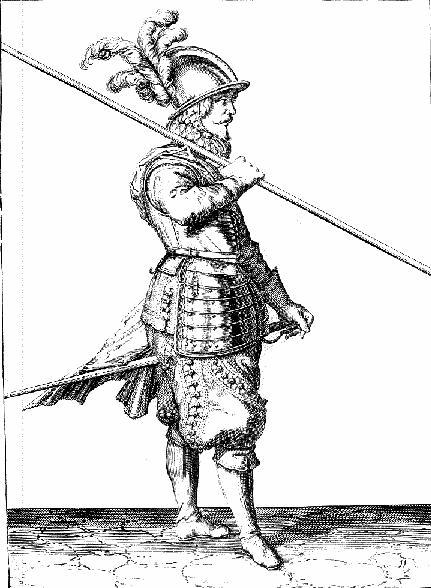
Slope your Pike
In the 11 how he shall carye the Pike slopinghe to avoyd the danger
of hurting on an other when they marche close: and in the next figure shall
beshewed how he (carrying the Pike levell or slopinge) shall let the same
sinke whensoever he will come to porte or otherwayes charge the pike, and
how he shall set the same at three tymes againe upon the ground, and desiring
to laye the same upon the shoulder, shall doe it at three tymes, as is
taught before. But when he carrieth the Pike advanced he shall charge the
same at one tyme.
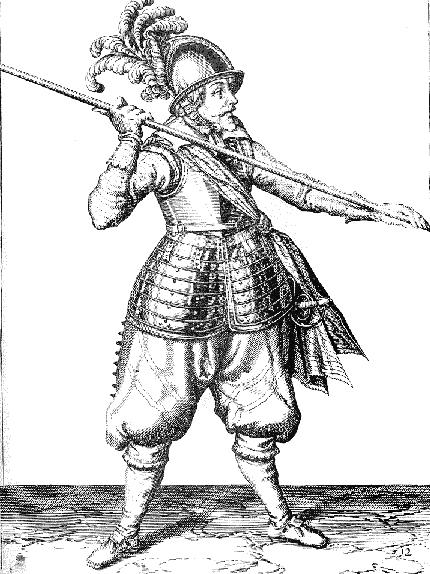
Porte your Pike (first motion)
In the 12. how he (before the first changeinge of hold) shall takethe
Pike with the left hand speedely as farr as he (standinge right) can reach,
liftinge the saeme with the left hand up from the shoulder, the better
and with more ease to be ableto cast the Pike overwith the sharp ende before.
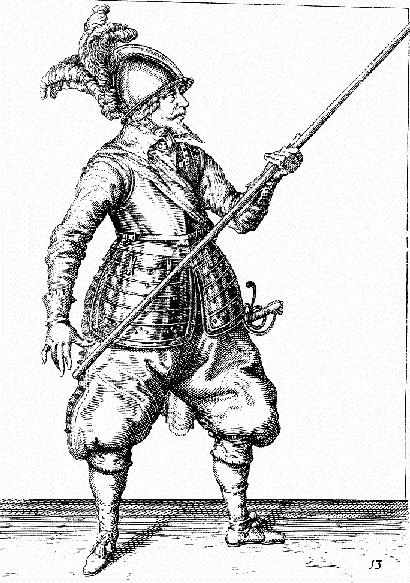
Porte your Pike (second motion)
In the 13. how he (before the second remoovinge of his hnd) having brought
the Pike with the sharpe end before, shall take the same with the right
hand under at the end and lettinge it sinke handsomely downewards, shall
so the more conveniently passe through the porte.
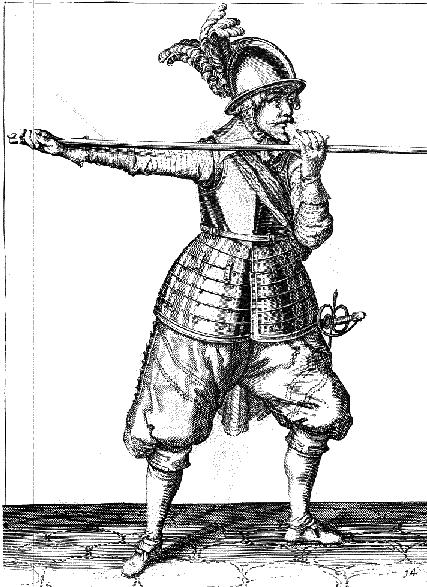
Porte your Pike (third motion)
In the 14 how he (at the thirde tyme) shall duely charge the Pike,
the right arme stretcht out, havinge the same well in the right hand, setting
the left elbowe fast against the hippe, and shall be taught how he shall
est downe the Pike againe at three tymes or motions.
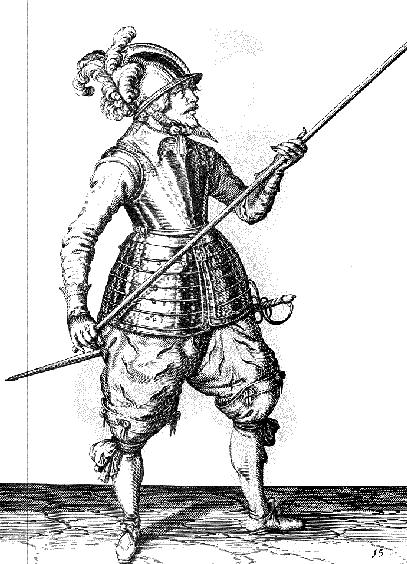
Order your Pike (first motion)
In the 15. how he (before the first changeinge of hands) with his right
hand shall put downe the butt ende of the Pike, the better and more easelye
to rayse the sharp end of the same.
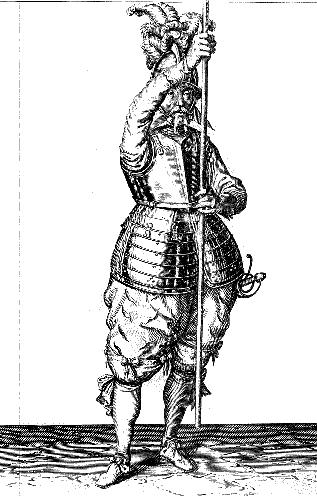
Order your Pike (second motion)
In the 16. how he ( before the second changeinge of hand) shall take
holde of the Pike with the right hand (above the left) so farr as hee easely
can reache.
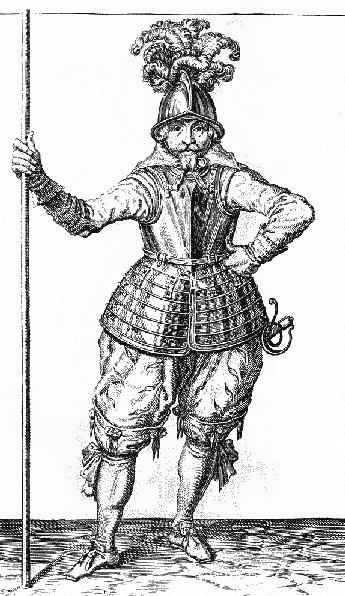
Order your Pike (third motion)
In the 17. how he shall at the thirde tyme, sett the Pike downe to
the ground, guyde it against the thumbe, and hold the same well as is sayd
at the first figure, and shall in the two next figures be shewed, how he
carrying the Pike up or advanced, shall charge the same at one tyme onely,
but because in the former figures is sufficiently taught how he (the Pike
standing downe) shall takeit up againe, it shall therefore be needlesse
to demonstrate it againe with the figures, but thus much shall eserve onely
for remembrance.
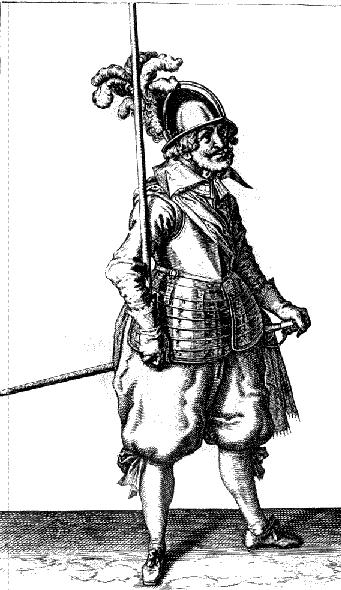
Advance your Pike (third motion) (first and second motions
are in plate 2 and 3 above)
In the 18. how, havinge at three times (as is sufficiently sayd heretofore)
taken the pike from the ground an the but end in his hand he shall guyde
and carrye the same advanced in the right hand against the same arme.
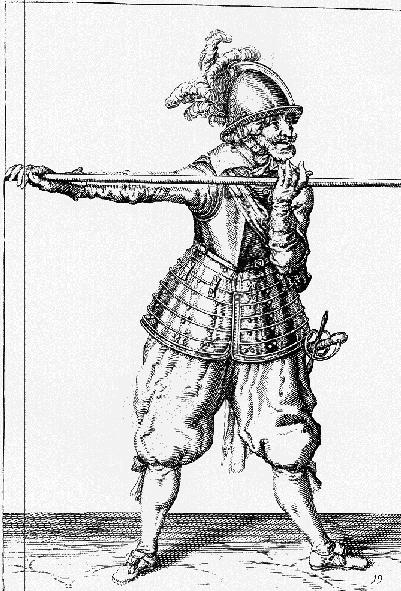
Charge your pike at one motion.
In the 19. how he (havinge the Pike advanced) shall take the same with
left hand higher and at the same tyme charge withall, but if he desire
to set the Pike downe again, he shall doe it as is taught by the figures
before. But if (having charged the Pike) he thesame againe advanced, he
shall doe it in one posture or motion.
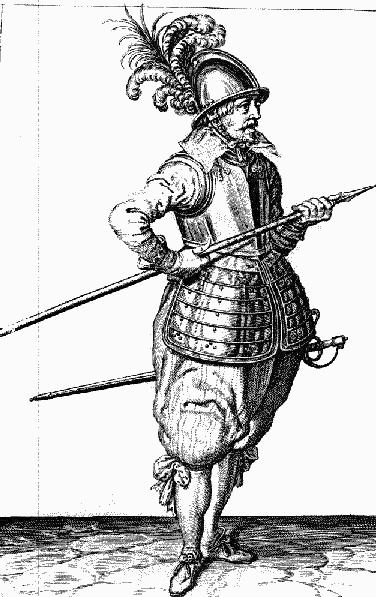
Cheeke your pike
IN the 20. how (standing at a porte at the marchinge in or out of any
men) he shall hold the Pike at the point like as this figure sheweth.
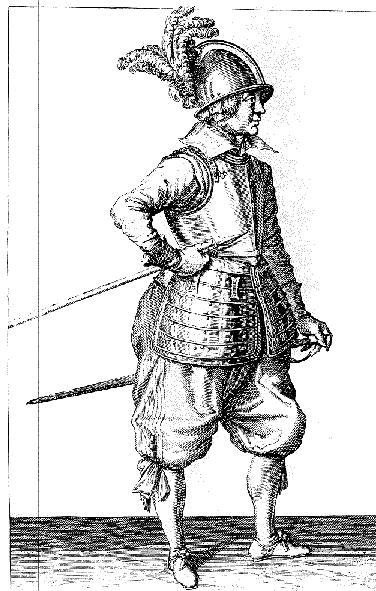
Trayle your pike
In the 21. how he ( trayling the Pike) shall hold the same close at
the point and set the right hand above the hippe fast to the bodye, and
if he will charge or other wayes carrye the same, then he must (as it were)
measure the Pike by palmes, handling it with convienient distance, like
as the two next following figures shall shew.
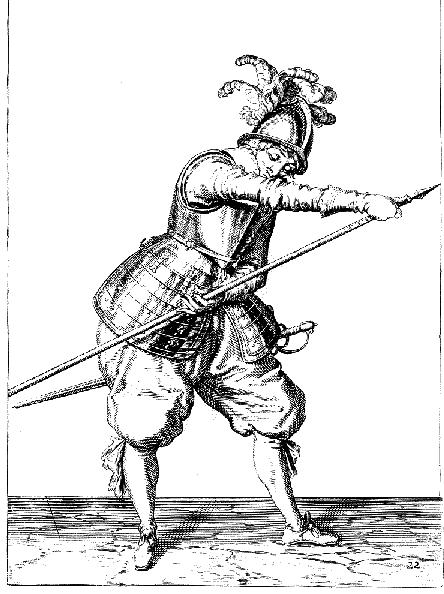
Palming your pike charge it (first motion).
In the 22 how (before the first changeinge of hands havinge first so
farr as he could put forward the Pike with the right hand) he shall
(bendinge himself a little) palme or hand-on the same speedely, takinge
it still from beneath or belowe.
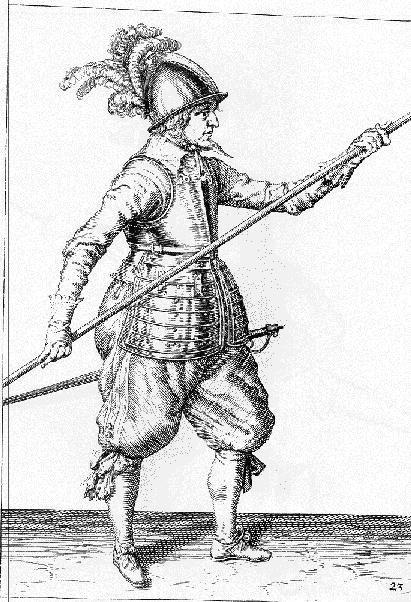
Palming your pike charge it (second motion)
In the 23, how he (palminge forward) shall bringe the Pike with the
left hand yet more forward, havinge brought the right hand which was the
foremost before, to be now behynde upon the second change of the hande.
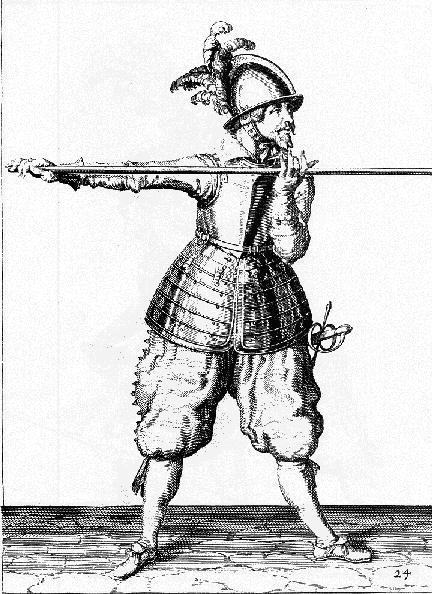
Palming Your pike charge it (third Motion) (More than
three motions are allowed)
In the 24. how (havinge brought the Pike (by palminge) forward to the
end and having the same sure in his hand, he shall charge the same: but
if he would in the former manner (that is traylinge) carry the sayd Pike,
lett (hym by the sayd manner of palminge) bring the same backward againe.
Here is to be considered that (although there be but two palminge figures
here set downe, which some might take as if it were sayd that just in three
remooves of the hande the Pike could be charged yet is not that our meaninge,
but that following the exampleof those two paliming figures) the learner
must know that he is to palme orhand the Pike ( by shifting hands) so long
till he have recovered the loweer or butt end of the Pike into his right
hand.
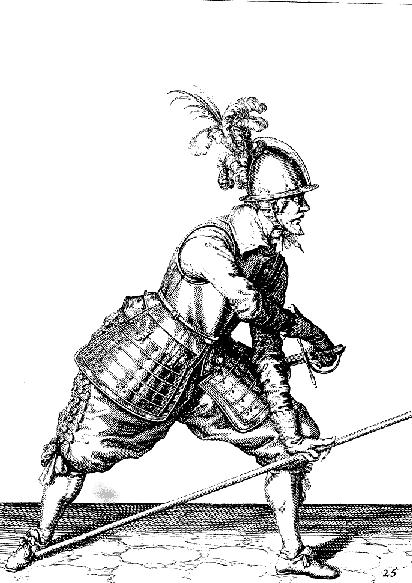
Charge your pike at the right foote and draw your sword.
IN the 25. how he (expecting horsemen) shall set the Pike against ther
right foote and draw his sword over the left arme, like as this figure
sheweth.
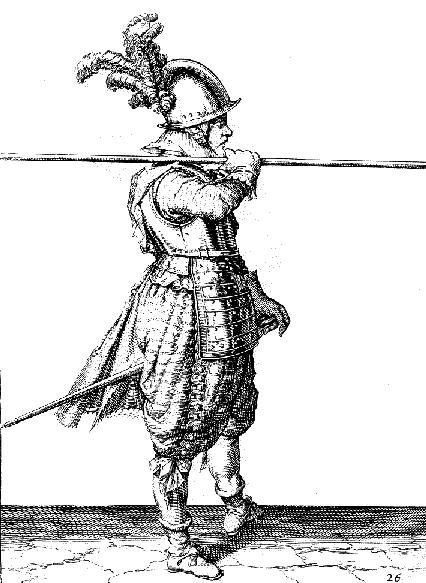
Shoulder your pike.
IN the 26 how, marchinge with the Pike upon the shoulder, he shall conveniently
turne hymself to the left hand ( if need be) and charge the Pike backward
in three motions or remooves of the hand.
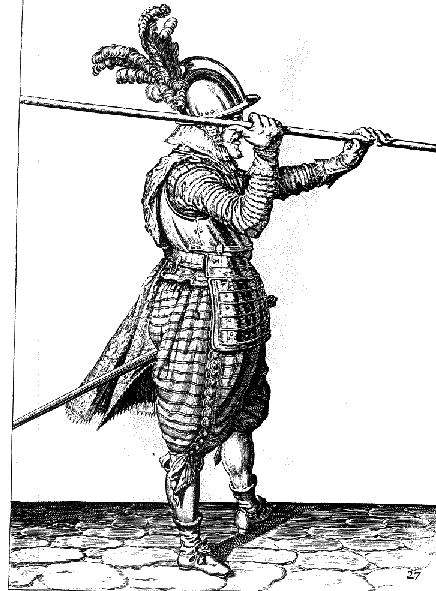
Charge your pike backword (first motion).
In the 27. how he (before the first changeinge his hold or remoove
of his hand havinge first with the right hand advanced the Pike from the
shoulder) shall at the same thyme take hold of it some what foreward with
the left hand becausse in so doinge he maye more easely lifte the Pike
over his head.
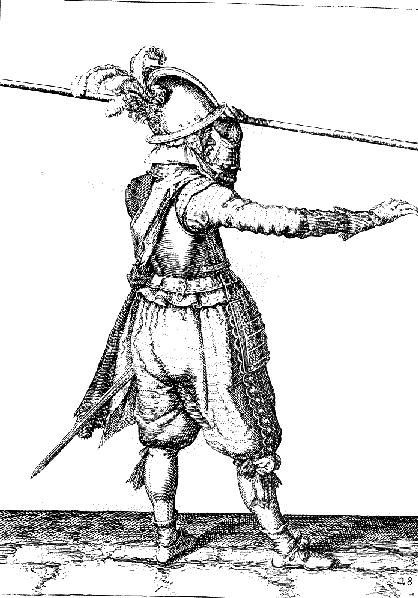
Charge your pike backword (second motion)
In the 28. how (having the pike over the heade in the left hand and
already turned himselfe to the left side) he shall ( for the second remooving
of hold) take the same with the right hand under at the ende.
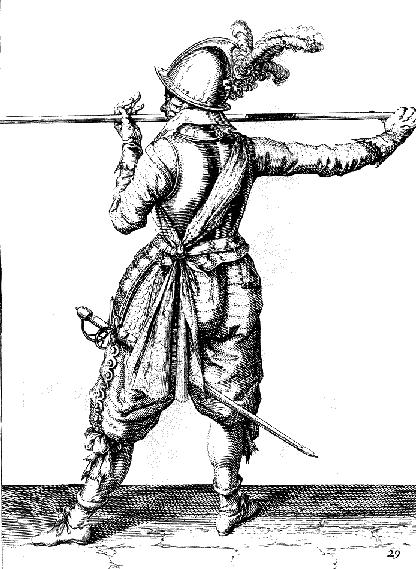
Charge your pike backword (third motion)
In the 29. how (as it is saide before) he shall the third time change
the Pike backward and stand turned about. the ghree following figures
shall shew how he shall turne himselfe in three motinons and alsoe how
he shall stande or marche, like as is seene in the 26 figure.
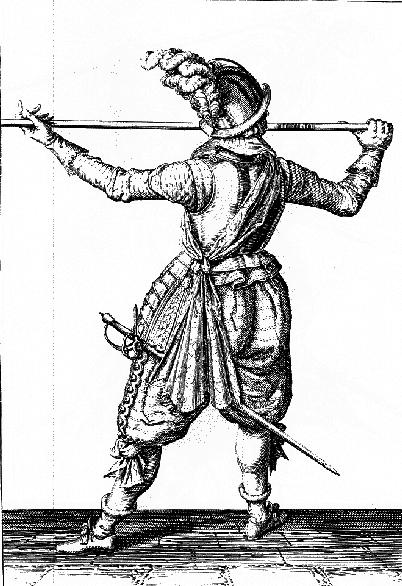
Right to your order and your pike slope (first motion).
In the 30. how he (before the fist removing of the hand) shall reach
and take the Pike further with the left hand and prepare himself to turne.
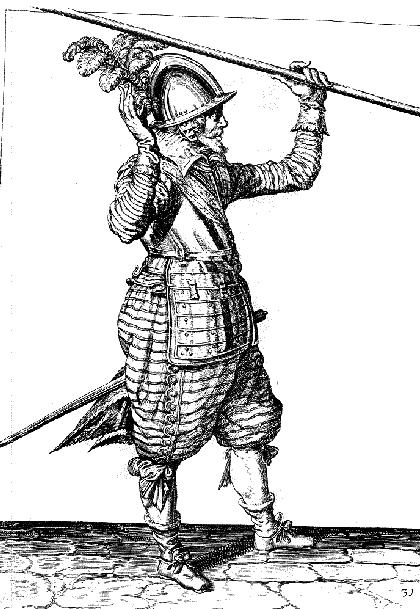
Right to your order and your pike slope (second motion).
In the 31 how (having already turned himselfe to the right side) he
shall lift the Pike over his heade with the left hand and take the same
somewhat more backward with the right hand.
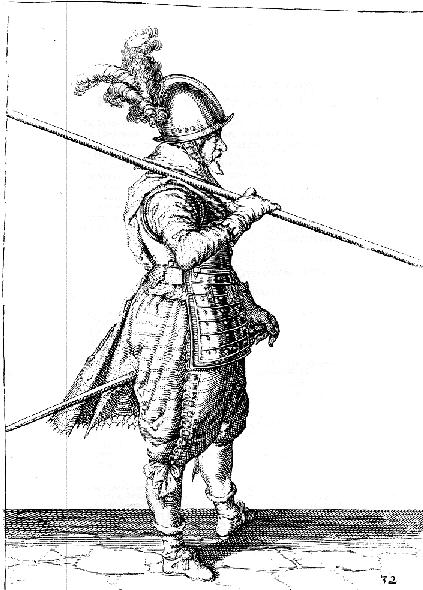
Right to your order and your pike slope (third motion).
In the 32. how he (for the third time) shall carry the Pike againe in
the right hand upon the shoulder sloped levell or advanced if neede bee.
And seeing expereince teacheth that the souldier can not speedily nor handsomely
change the order of his Pike, but through knowledge how to handle and hold
the same well, threfore are there, for his better instruction, certain
wordes of command hereby annexed togetherwith the tymes of changing or
removinge of the handes, which doe alltogether agee with the rules of instruction,
as alsoe with hte Cypher numbers alloted to each severall picture to the
ende that the Capitaines may shew or theach their new untrayned Souldiers
the handling of the Pike after this manner. I menne soe much as is necessary
for their use, but having once obtained the handling thereof, the Souldier
shalbe then exercised with the words of command onely, which worders are
sett hereafter apart, without the distinctions of times or motions, such
as here immediately doe follow.
The wordes of Command with the Time of Changing of
Holde
1. Your Pike being ordered or standing downe advance
it at three time or mothyons.
2 the first
3. the second
Time or motion
4. the third
Order your Pike
5. the first
6. the second
Time.
7.the third
Shoulder your Pike and carry it levell.
8. the first
9. the second
Time.
10. the third
11. Slope your Pike
Porte your Pike.
12. the first
13. the second
Time
14. the third
Order your Pike
15 the first
16. the second
Time
17.the third
Advance your Pike at three times or motions.
18. These three motions have but one figure marked with
the number 18. because the other two are showed before in the 2 and 3 figures.
19. Charge your pike at one motion.
20. Cheeke your pike.
21. Trayle your pike.
And palming your pike charge.
22. Not bound to doe this at 3 motions
23. or times, as is saide in the instructi
24. on numero 24.
24. Change your pike at the right foote and draw your
sword.
26. shoulder your pike. Charge backword.
27. the first
28. the second Time
29. the third
Right to your order and hyour pike slope.
30. the first
31. the second Time
32. the third
The words of command in genreall after which the captaines
shall see their Souldiers exercised when the Souldier is come soe farre
that he can handle his pike as becommeth; it is then to be understoode
that for orders sake these words following (sofarre as is needefull) are
sett downe agreeing to the former which have their reference to the pikemen,
exepting some onely which in the order of the pike doe the same action
that hath beene shewed inough bhy the figures with their times or motions.
Alsoe that at the first command, where it is saide advance your pike, it
is spoken to the first figure, that standeth still in order with his pike
sett downe, and the better to prevent all cconfusion, it must be remembered
that every manner of carryinge or charging ofthe Pike must be done apart,
and noe other begun or taken in handle till the first be done and the Pike
sett dowwne order again. To which purpose this generall command shalbe
used or observed
The words of Command
Order your Pike
Advance your Pike
Set downe your Pike
Shoulder your Pike
Levell your Pike
Slope your pike
Porte your Pike
Order your Pike
Advance your Pike
Charge yoru Pike
Order your Pike
Cheeke your Pike
Ordry your Pike
Trayle your Pike
Charge hyour Pike
Order your pike
Charge your Pike against the right foote and draw your sworde.
Order your Pike
Shoulder your Pike.
To return to the tip top of this page click
here.
To return to the military page click
here
To the main cultural menu click
here
